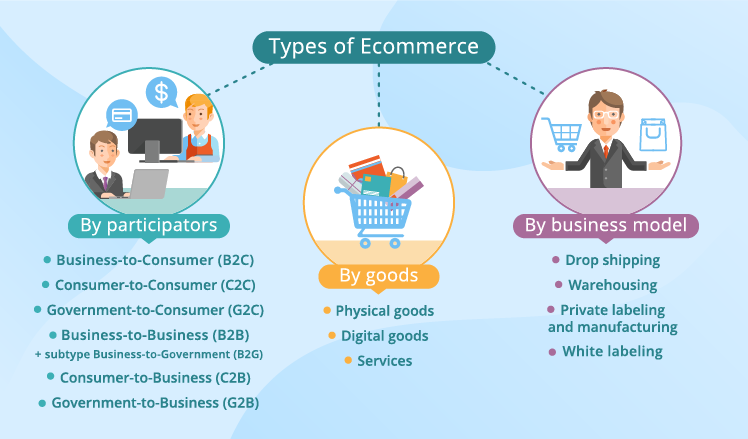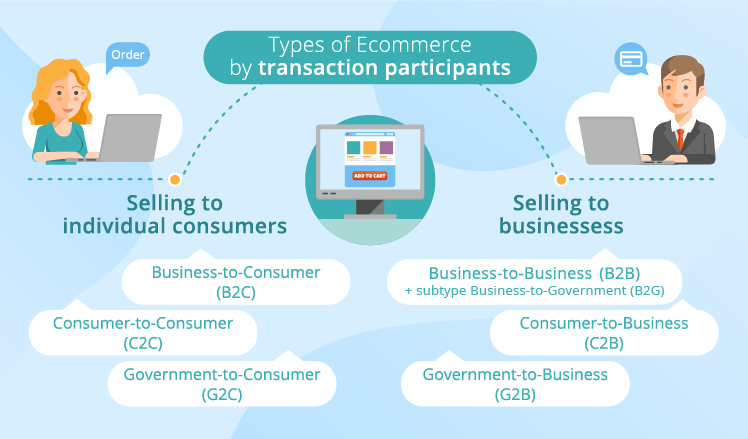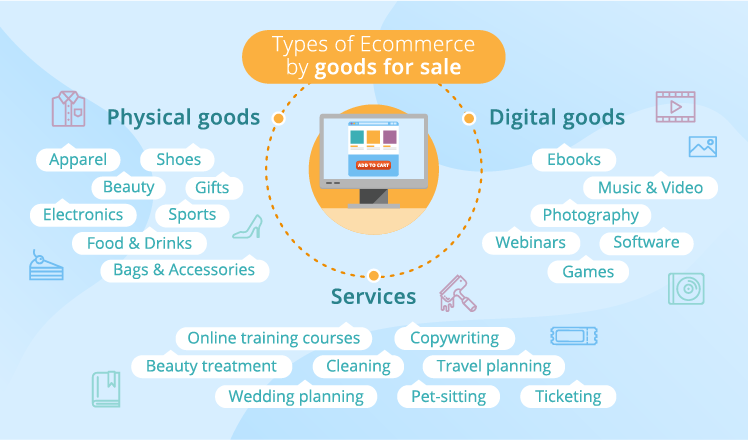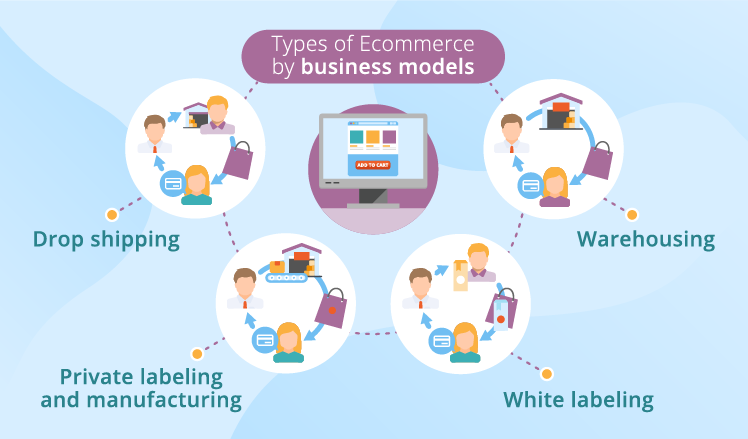Types of Ecommerce: General Overview, Examples and Success Tips
Editor’s note: For this article, we’ve brought together our knowledge of different ecommerce types. We expand the theory with our practical experience whenever possible to give you real illustration of how ecommerce development practice unfolds differently depending on a business model.
Throughout our blog and practice, we always talk about how no two ecommerce businesses are the same and stress the importance of focusing predominantly on your business specifics and goals. Still, we admit that knowing certain similar patterns can help launching and managing an ecommerce business with greater success – after all, most of the failures have already been survived by someone else, and now you can learn from the accumulated experience.
There is a number of criteria to classify types of ecommerce. We’ve chosen the three most important: transaction participants, goods for sale and business models.

The types of ecommerce by the parties involved
Within this classification, six types are outlined in ecommerce: Business-to-Business (B2B) with its subtype Business-to-Government (B2G), Business-to-Consumer (B2C), Consumer-to-Business (C2B), Consumer-to-Consumer (C2C), Government-to-Business (G2B) and Government-to-Consumer (G2C). In general, identifying and then targeting the right audience is a matter of importance. A general look at the buyer side can only be the starting point, though it provides certain value as well. 
Selling to consumers
Companies, where buyers are individual consumers, feature a short sales cycle, price sensitivity and a high possibility of impulse purchases. Sellers win when they bet big on consumers’ emotions:
- Personalize customer communication (launching targeted marketing campaigns).
- Bond with customers (telling the seller’s story, engaging in social media, responding to customer feedback, extensively using soft selling marketing techniques like valuable content).
- Encourage customer loyalty (asking for customer opinion in surveys, incorporating loyalty programs).
- Provide smart assistance throughout a shopping journey (offering product recommendations based on a customer’s browsing activity, a comprehensive customer profile with previous and abandoned orders, preferences and wish list, and proper customer support).
Business-to-Consumer
The B2C type is the most widespread in ecommerce, thus the market in each product line is really competitive. Here, focusing on smaller, yet profit-generating, target audience is business-critical. This goes without saying that in our practice we frame B2C projects around the target audience.
B2C project example
The company offers a delivery service of organic product boxes across the country. What their customers are expecting is convenience – a time-saving ordering process and no delays in delivery. On the website, we design a smooth journey – customers may vary products in the boxes, subscribe for regular delivery and reorder instantly. Also, we integrate ecommerce with the company’s back office to organize order processing, dispatch and delivery properly.
Consumer-to-Consumer
Within the C2C type, consumers sell assets or services to other consumers online. To place sales advertisements and connect to potential buyers, individuals use a third-party business (an ecommerce website or an online marketplace). Ebay and Amazon are two prominent C2C ecommerce providers.
Government-to-Consumer
Online transactions can streamline communication between governmental organizations and citizens. Possible activities may include information sharing, paying fees (for education, rent, consulting services, etc.), renewing licenses and more.
G2C project example
A telecommunications company provides government-subsidized mobile networking services. They don’t need complex, heavily-customized business logic on the website as their ecommerce operations are pretty straightforward. However, they use a feature-rich ecommerce platform that is license-free, yet expensive in terms of support. We start the cooperation with the analysis of the ecommerce functionality needed to support the business. As a result, we offer and then migrate the website to an alternative platform – commercially viable and with sufficient functionality. Now, the company stays within their support budget.
Selling to businesses
Having businesses as potential buyers comes with its pros and cons. On the bright side, sellers have a larger average order value and a high chance of wholesale purchases (the two are often interconnected). On the downside, a sales cycle is generally longer and several decision-makers may be involved. Thus, the focus should be on establishing the trust-based long-term relationship with customers. Given that the purchasing process is far less emotional but rather rational, sellers’ most favored techniques include:
- Offering custom pricing (price quotes, loyalty perks, bonuses for wholesale orders).
- Giving flexibility in placing orders (valued customers may need or prefer placing orders by phone or email).
- Providing for placing quick repeat orders.
- Making account registration mandatory (but certainly quick and user-friendly) to keep in touch with customers further on.
- Recognizing the importance of after-sale support.
Business-to-Business
At first sight, it seems that the name explicitly suggests that both participants in B2B ecommerce are businesses, for example a manufacturer or a wholesale supplier selling to a retailer. However, B2B ecommerce has one more face – multi-vendor marketplaces. Though end buyers are individual consumers, a marketplace owner sells digital space to business vendors, thus conducting B2B transactions.
Tips to manage a multi-vendor marketplace effectively
Having launched a number of marketplaces, we strongly recommend – automate as much as possible and give vendors self-service tools to accelerate time-to-market. If you want to reward vendors with the highest sales – set rules to track sales activity and trigger loyalty bonuses automatically. Consider attribute-based product information management – vendors will clearly see what product characteristics they need to provide.
Watch a multi-vendor marketplace demo
We mention B2G (business-to-government) companies as part of the B2B type as the core idea of this classification is to distinguish between individual and corporate ecommerce participants. Thus, we see both private and governmental organizations as a business, as opposed to an individual participant.
Consumer-to-Business
In the C2B model, individuals – entrepreneurs or freelancers – offer goods or services to companies. For example:
- A web designer building a company’s website.
- A photographer picturing product catalogs.
- A caterer working on corporate events, conferences or business meetings.
As for individuals, they can (and should) employ diverse marketing channels to sell their services effectively: for example, they showcase portfolio and collect customer feedback on an ecommerce website and expand their online presence via job listings and social media.
Government-to-Business
G2B is online commercial interaction between governmental and private corporations. As a rule, a G2B model gives companies a convenient way to deal with payments and legal procedures, like document renewal, cutting down significantly on bureaucratic foot-dragging and paper work. A classic G2B example is a government website where businesses go to pay taxes.
The types of ecommerce by goods
This classification is important as the product profile in ecommerce largely defines a seller’s business plan.

Physical goods
Choosing to sell physical goods, online retailers compete with traditional brick-and-mortar businesses and their major competitive strength of a real-life purchasing experience where a possibility to view and try on goods leads to more informed purchasing decisions. Consequently, ecommerce businesses need to show how online shopping can be a worthy alternative – accurate images and detailed product descriptions help with the purchasing choice, prompt expert assistance and how-to guides cover the role of sales assistants, customer-friendly delivery and return terms add to customer risk-taking. Moreover, there are so many advanced technologies and approaches to power your ecommerce for superior customer experience. We took time to outline the possibilities within our custom ecommerce development offering.
Digital goods
In a way, selling digital goods sounds tempting: there are low overheads due to the absence of inventory costs and delivery limits. However, sellers may face tough competition with free content or software and should stress the benefits of purchasing goods rather than getting them for free. For example, when launching an image-sharing resource, entrepreneurs can bet on the high quality of provided assets and the importance to reward contributors.
Services
From our ecommerce consulting practice, we can recall success tips that are likely to work with all kinds of services sold online and both business models – a single-vendor service business and a service marketplace. Let’s say upsell opportunities are vast as customers may only have a rough idea of how to organize the service most effectively and expect a seller to build on it. And an online calculator will provide for price transparency. Also, ecommerce companies selling services definitely need to engage phone or email communication channels to settle the details and finalize the deal with a customer.
Still, the nature of services impacts a number of business aspects. Companies offering repeat services win with a subscription-based model – for example, a cleaning business can offer customers a possibility to set a regular cleaning schedule. Besides, such a retailer should mind the geographical limits of their business.
The types of ecommerce by business models
The way online retailers organize their supply chain is a constituent of their ecommerce business model. As summarized, there are 4 possible options.

Drop shipping
Retailers may partner with a wholesale supplier who stores the inventory and delivers ordered items directly to a customer upon the purchase. Thus, sellers save on inventory costs and don’t keep goods in stock at all. This model seems to offer a fast buck as retailers need only to be present online and serve as an intermediary between customers and a drop shipper. In fact, there are downsides including the low margin, lack of control over the supply chain and high competition. Moreover, drop shipping makes brand image building impossible.
Warehousing
Retailers may purchase goods from a manufacturer, manage their own warehouse and organize the delivery to customers. Undoubtedly, this requires more initial investment into product sourcing and inventory management. Full control over all business processes and flexibility in choosing the product assortment come as a bonus.
Private labeling and manufacturing
Retailers may outsource manufacturing and sell goods under their brand name. On-demand manufacturing allows retailers to have their goods designed in line with their specifications or prototypes and avoid expenditures related to managing their own production.
White labeling
Retailers may purchase generic products manufactured for multiple companies and offer them under their brand name. Sellers save on the design and development of their product but still have their products communicating a brand message.
Some statistics at conclusion
Certainly, we can’t say that one ecommerce type is better than the other – a retailer can build a successful business with any of them providing that their business strategy is well-thought-out. Still, it is interesting and useful to know what types dominate the market now, isn’t it? Here are some figures.
Currently, the global B2B ecommerce market, valuing US$10.6 trillion in 2018, is over 5 times larger than the B2C market. The top positions among product lines are occupied by fashion (61%), travel (59%), and books and music (49%). As for supply chain models, inventory management and warehousing is ramping up – the number of warehouses in the US has increased 6.8% over the past five years.

